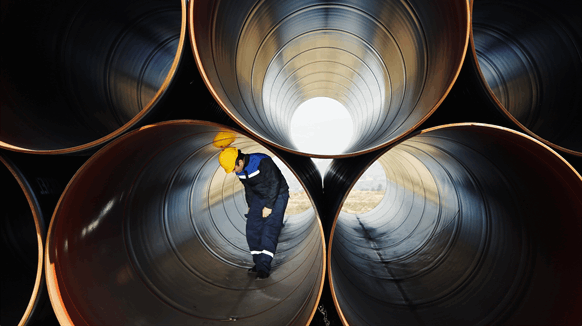Canada's Output Grows Despite Pipeline Problems

(Bloomberg) -- Canada’s lingering crude glut isn’t hindering the country’s growing oil output, according to the National Energy Board’s most recent forecast.
The country’s oil production will average 4.59 million barrels a day, 22,000 more than previously forecast, data from the Canadian energy regulator show. The raised production outlook comes even as pipeline bottlenecks have driven Canadian crude prices to record lows and prompted some producers, including Canadian Natural Resources Ltd. and Athabasca Oil Corp., to reduce output by about 160,000 barrels a day, according to estimates by TD Securities Inc.
The biggest driver of higher output is heavy oil-sands crude, which is forecast to have exceeded 2 million barrels a day in October to average 1.88 million daily barrels for the year. That’s 42,000 barrels a day more than the previously forecast. Output of conventional light and heavy oil also exceeded the earlier forecasts.
The increase might reflect the faster-than-expected ramp-up of Suncor Energy Inc.’s Fort Hills oil sands mine, according to Stephen Kallir, upstream research analyst at Wood Mackenzie in Calgary.
The 194,000 barrel-a-day Fort Hills mine started operation earlier this year and will run at 90 percent of capacity through the fourth quarter, Suncor Chief Executive Steve Williams said on a Nov. 1 conference call.
“They are producing above 90 percent capacity as of end of the third quarter,” he said by phone. “We expected that early next year.”
To be sure, the NEB recent data shows production trailing off in December with output lower than forecast earlier.
Heavy Western Canadian Select crude fell below $14 a barrel on Nov. 15, the lowest in Bloomberg data extending back a decade. The crude’s discount to West Texas Intermediate futures widened to $50 a barrel in October, also a record in data extending back 10 years. The price fell $1.17 to $17.96 a barrel on Tuesday and the discount widened $1 to $33.50 a barrel.
The data did show signs of possible stress. Output of oil sands bitumen that’s processed in an upgrader to make light, synthetic crude plunged to 890,000 barrels a day in September from 1.13 million barrels a day in August and will end the year below prior estimates. The drop happened as upgraders belonging to Syncrude Canada Ltd., Suncor and Canadian Natural Resources were undergoing maintenance. The NEB had projected in September that output of upgraded bitumen for the month would be 1.06 million barrels a day.
To contact the reporter on this story: Robert Tuttle in Calgary at rtuttle@bloomberg.net. To contact the editors responsible for this story: David Marino at dmarino4@bloomberg.net Catherine Traywick, Margot Habiby.
WHAT DO YOU THINK?
Generated by readers, the comments included herein do not reflect the views and opinions of Rigzone. All comments are subject to editorial review. Off-topic, inappropriate or insulting comments will be removed.
- What's Next for Oil? Analysts Weigh In After Iran's Attack
- Venezuela Authorities Arrest Two Senior Energy Officials
- CNOOC Bags Contract for 4.6 MMcf of LNG for Philippines
- EU Gas Storage Nearly 60 Percent Full at End of Heating Season
- EIA Raises WTI Oil Price Forecasts
- ExxonMobil Makes FID on 6th Project in Contested Guyana Asset
- Is The Iran Nuclear Deal Revival Project Dead?
- ORE Catapult Looks for New CEO as Jamieson Steps Down
- Japan's Mizuho Invests $3.64MM in Bison's CCS Project in Alberta
- Equinor Advances First Battery Storage Projects in USA
- Macquarie Strategists Warn of Large Oil Price Correction
- JPMorgan CEO Says LNG Projects Delayed Mainly for Political Reasons
- USA, Venezuela Secretly Meet in Mexico as Oil Sanctions Deadline Nears
- EIA Ups Brent Oil Price Forecast for 2024 and 2025
- Petrobras Discovers Oil in Potiguar Basin
- EIR Says Oil Demand Will Not Peak Before 2030
- Biden Plans Sweeping Effort to Block Arctic Oil Drilling
- Pantheon Upgrades Kodiak Estimates to 1.2 Billion Barrels
- Dryad Flags Red Sea 'Electronic Warfare' Alert
- Russian Oil Is Once Again Trading Far Above the G-7 Price Cap Everywhere
- Oil and Gas Executives Predict WTI Oil Price
- New China Climate Chief Says Fossil Fuels Must Keep a Role
- Chinese Mega Company Makes Another Major Oilfield Discovery
- Oil and Gas Execs Reveal Where They See Henry Hub Price Heading
- Equinor Makes Discovery in North Sea
- ExxonMobil Racks Up Discoveries in Guyana Block Eyed by Chevron
- Macquarie Strategists Warn of Large Oil Price Correction
- DOI Announces Proposal for Second GOM Offshore Wind Auction
- Standard Chartered Reiterates $94 Brent Call
- Chevron, Hess Confident Embattled Merger Will Close Mid-2024


